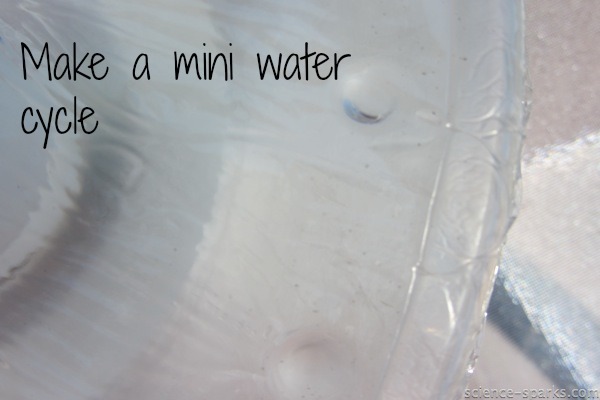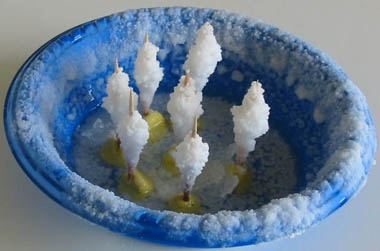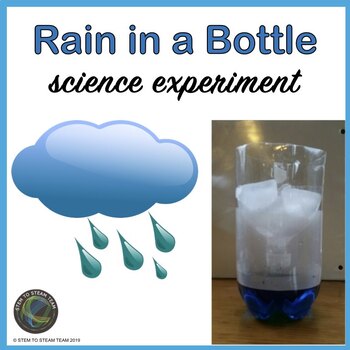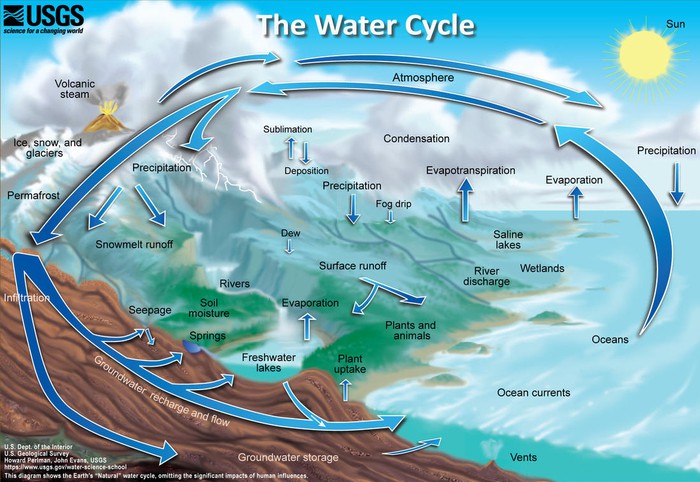38 water cycle science project
What Is the Water Cycle? | NASA Climate Kids What Is the Water Cycle? The Short Answer: The water cycle is the path that all water follows as it moves around Earth in different states. Liquid water is found in oceans, rivers, lakes—and even underground. Solid ice is found in glaciers, snow, and at the North and South Poles. Water vapor—a gas—is found in Earth's atmosphere. Water Cycle and Climate Extremes Modeling - Energy The Water Cycle and Climate Extremes Modeling (WACCEM) Scientific Focus Area represents sustained effort to advance predictive understanding of water cycle processes and their subseasonal-to-multidecadal variations and changes through foundational research using models, observations, and novel numerical experiments and analysis methods. With the ultimate goal of improving predictability of ...
Water Cycle Science Fair Project Ideas | Study.com Dissolve 1 tablespoon salt in ¼ cup of warm water. Lay 3 sheets of black construction paper on a trash bag next to a window. Pour saltwater mixture on one sheet of paper. Pour ¼ cup of saline...
Water cycle science project
Water Cycle in a Bottle Science Experiment - A Dab of Glue Will Do Doing the Water Cycle in a Bottle Experiment. Let the kids decorate their bottles with clouds, water and rain drops. Turn the bottles upside down inside a cup. Discuss the water cycle and why water evaporates and rains. Place a couple of ice cubes on top of each bottle and set it in a sunny location. Check the bottles after about an hour. Water Cycle, Rain Cycle Science Experiments and Craftivity These simple science experiments will help demonstrate the water cycle or parts of the water cycle. Experiment 1 Items Needed: large bowl mug or small cup plastic wrap string or large rubber band water Place the mug or small cup in the center of the bowl. Fill the bowl with water about 2/3 of the way up the cup (do not put water inside the cup). 5 Water Cycle Experiments Your Kids Will Love - Blessed Homeschool Pour boiling water into the glass bowl and mix until all of the salt has dissolved. Place the small bowl in the center of the large bowl (make sure it doesn't float). Cover the large bowl with cling wrap (not too tight or too loose). Place a handful of ice cubes in the center of the cling wrap. Let the natural process of the water cycle begin.
Water cycle science project. Water Cycle - Rookie Parenting In this simple "water cycle in a bag" experiment, we will observe the different stages of the water cycle process up close. Print Materials a ziplock plastic bag (I used 2 Gallon bag) color markers (e.g. Sharpie Permanent Markers or any non-erasable markers) water blue food coloring (optional) packing tape Tools adult supervision Instructions 2 FUN, Hands-on Water Cycle Activities for Kids - 123 Homeschool 4 Me Water Cycle Activities for Kids. If you are teaching kids about the water cycle, you will want to see these fun water cycle activities. These are great additions to add to your water cycle lesson plan with preschoolers, kindergartners, grade 1, grade 2, and grade students.Whether you want an easy water cycle craft for kids or a simple water cycle science experiment - you will love these ... The Water Cycle! With 25 Science Projects for Kids The Water Cycle! With 25 Science Projects for Kids is part of a set of four Explore Earth Science books that explore the earth, the atmosphere, and everything in between. The other titles in this series are Weather and Climate! With 25 Science Projects for Kids, Natural Disasters! With 25 Science Projects for Kids, and Rocks and Minerals! Water Cycle Project | DIY Science Project Ideas - Osmo Kids Learning This water cycle project idea to build a 3 dimensional model of the water cycle helps children see the different steps of the water cycle. This demonstration helps them observe and visualize each step of the water cycle. Things You'll Need Wooden board 2 sheets of cardboard 2 sheets of blue-colored chart paper
Water Cycle Working Model (Science Project) - YouTube fill the water in the blue tray in which the water pump is fixed.when we on the switch, the water pump throw the water of the blue tray to the clouds through the pipe which is connected from the... The Water Cycle! With 25 Science Projects for Kids Illustrated by Tom Casteel. The Water Cycle! With 25 Science Projects for Kids invites kids ages 7 to 11 to take a deep look at the world of water. Combining hands-on activities with history and science, The Water Cycle invites kids to have fun learning about the water cycle, water resources, drinking water and sanitation, water pollution and ... 30 Water Experiments For Kids - Little Bins for Little Hands Explore water science with one of these fun theme ice melt activities. LEGO WATER EXPERIMENT Build a dam from Lego bricks and explore the flow of water. OCEAN CURRENTS Build a simple model of the ocean currents with ice and water. OCEAN LAYERS Just like layers of the earth, the ocean has layers too! How to Teach the Water Cycle to 5th Graders - A Teacher's Wonderland Water Cycle Activities: Anchor Chart The Bag Experiment This is an oldie but an absolute goodie!! I LOVE putting some water in a bag about 30% full, then adding blue dye to it. Before we put it on the wall (or add water) we label the parts of the water cycle. Then we hang it on the window. After a day or two, the water will "rain" inside the bag.
Water Cycle - Process and its Various Stages - BYJUS The water cycle has a tremendous impact on the climate. For instance, the greenhouse effect will cause a rise in temperature. Without the evaporative cooling effect of the water cycle, the temperature on earth would rise drastically. The water cycle is also an integral part of other biogeochemical cycles. Water cycle affects all life processes ... Water Cycle Project-4th Grade Science - Pinterest Aug 7, 2020 - Explore Tiffany Giroir's board "Water Cycle Project-4th Grade Science", followed by 523 people on Pinterest. See more ideas about water cycle, 4th grade science, water cycle project. Water Science Experiments for Kids - Fun Science for Kids Water Cycle Experiments. Make a mini water cycle or a water cycle in a bag. These are great science activities for older children and really help explain a tricky concept. Water and Density. Density is a really tough concept to grasp, but hopefully this density science trick is interesting and simple enough to help it all make sense. 11 Activities to Teach Water Cycle Science Precipitation is a critical step in the water cycle as it involves liquid or frozen water falling to the Earth. It can be observed in weather events like snow, hail, and rain. The melting of frozen water (ice) also puts water back in motion in the water cycle. 5. Track Rainfall
Water Cycle Activities for Middle School Science MS ESS2-4 - Develop a model to describe the cycling of water through Earth's systems driven by energy from the sun and the force of gravity MS ESS3-1 - Construct a scientific explanation based on evidence for how the uneven distributions of Earth's mineral, energy, and groundwater resources are the result of past and current geoscience processes
The Water Cycle In A Baggie - An Easy Science Project Step #3 - Observe the water cycle in a baggie. Next, use a strip of packing tape along the top of the baggie to hang it onto a sunny window. (If it doesn't seem secure, tape around all the edges.) Now, you should be able to observe the water cycle in your baggie. If you aren't seeing evaporation, condensation, and precipitation, your ...
How to Make a Working Indoor Water Cycle for Kids Water Cycle Science for Kids - Instructions Step 1. Add 2 tsp of salt into the large bowl This step is completely optional, and does not impact how the experiment works. I like to add salt to the water because it represents sea water. As the water goes through the water cycle process, it will turn into freshwater.
Water Cycle Project Ideas - Science Struck A simple procedure to make the water cycle project is presented below. Refer to the following instructions to learn about how to make a simple water cycle for kids. Materials A medium-sized glass bowl Small cup for collecting the condensed water Plastic film Weight to be placed on plastic film Adhesive tape Procedure
STEM Water Projects and Science Experiments For Kids Build A Water Clock and learn a bit about history with this easy STEM project. This project can be scaled for use by kids of all ages. Ice STEM Projects explore all the amazing things you can do when water enters a solid state, better known as ice! The dinosaur ice sculpture is just too cute and kids will love engineering their own ice creations.
4th Grade Science - Pinterest 4th Grade Science, Elementary Science, Homeschool Science, Science Classroom, Teaching Science, ... 3D Water Cycle Science Project for Kids.
Water Cycle Project Teaching Resources | Teachers Pay Teachers 5.0. (45) $2.50. PDF. In this Water Cycle Project, students create a 3-D model of the Water Cycle using fun and creative materials. Students must also write a one-paragraph summary of the Water Cycle and include an alphabetical glossary defining: condensation, precipitation, infiltration, collection, and evaporation.
The Water Cycle - Experiments and Resources for ... - The Water Project An activity to illustrate how the water cycle helps to purify water. Condensation Make a Cloud in a Bottle Highlighting the concepts of air pressure and temperature in cloud making, this experiment uses a burnt match and some water to create a cloud inside of a plastic bottle. Due to the use of matches an adult is necessary. Precipitation
Make a Miniature Water Cycle Model | STEM Activity - Science Buddies Add one drop of food coloring to about 1/3 cup of water. Add 2 tablespoons (Tbsp.) of the colored water into each plastic bag. Keep the bags upright so as not to spill any water. Optional: Add 2-3 Tbsp. of sand to one side of each of the plastic bags. Part of the sand should be submerged, and part of the sand should be above the water level.
Water Cycle Science Project | model making | best out of waste ... Water Cycle Science Project | model making | best out of waste | science project | howtofunda#watercycle #watercycle #diymodel #howtofunda #watercyclemodel #...
3D Water Cycle Science Project for Kids - KC Edventures The water cycle includes three main parts: precipitation, evaporation & condensation. Basically, clouds produce some type of precipitation (rain/sleet/snow) which falls to Earth and then drains into our waters (lakes/rivers/oceans). As the sun heats the atmosphere, droplets from those bodies of water begin to evaporate into the air (or atmosphere).
Water Cycle in a Bag | Science Mission Directorate - NASA The activity pack includes resources for preK-8 learners. There are separate activity sheets for different learning levels and there is also an expanded version of the activity included for more advanced learners (grades 6-8) to explore WHAT evaporates and what is "left behind" in the water cycle. URL: Learn More Master Image: Age Level: Grades K-2
5 Water Cycle Experiments Your Kids Will Love - Blessed Homeschool Pour boiling water into the glass bowl and mix until all of the salt has dissolved. Place the small bowl in the center of the large bowl (make sure it doesn't float). Cover the large bowl with cling wrap (not too tight or too loose). Place a handful of ice cubes in the center of the cling wrap. Let the natural process of the water cycle begin.
Water Cycle, Rain Cycle Science Experiments and Craftivity These simple science experiments will help demonstrate the water cycle or parts of the water cycle. Experiment 1 Items Needed: large bowl mug or small cup plastic wrap string or large rubber band water Place the mug or small cup in the center of the bowl. Fill the bowl with water about 2/3 of the way up the cup (do not put water inside the cup).
Water Cycle in a Bottle Science Experiment - A Dab of Glue Will Do Doing the Water Cycle in a Bottle Experiment. Let the kids decorate their bottles with clouds, water and rain drops. Turn the bottles upside down inside a cup. Discuss the water cycle and why water evaporates and rains. Place a couple of ice cubes on top of each bottle and set it in a sunny location. Check the bottles after about an hour.


































0 Response to "38 water cycle science project"
Post a Comment